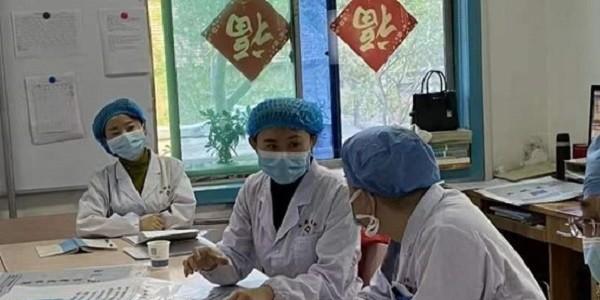Central Broadcasting Network Xi'an January 27 news One breath and one inhalation, thousands of worlds, behind every breath, there is a rhythm of healthy life. Today, walk into the "medical road" life of Dong Yu, director of the Department of Respiratory Medicine of Xi'an Central Hospital, and understand her and the "breathing" world in her eyes.
Dream "medicine" road breathing health
Dong Yu's mother is an obstetrician and gynecologist, she vaguely remembers that when she was a child, she often went to the hospital to find her mother, and she could not help but feel reverence for the profession of doctor, at that time, Dong Yu's heart planted a seed of "wanting to be a doctor".
When filling out the university volunteer, Dong Yu filled out all the volunteers to the medical school, and later, he was fortunate to be admitted to the school of medicine of North China University of Science and Technology. After graduating from her undergraduate degree, she came to Xi'an Central Hospital and officially became a respiratory physician. During his work, Dong Yu continued to pursue a master's degree at Chinese the People's Liberation Army Air Force Military Medical University (the Fourth Military Medical University) and a doctorate at Xi'an Jiaotong University with a tenacity, and with the growth of theoretical knowledge and clinical experience, Dong Yu went from a general doctor to a medical administrator. Daily routine rounds, checking inpatients and outpatients, on duty, teaching, scientific research... It's been almost 24 years.
Chronic obstructive pulmonary disease (COPD) is the most common chronic airway disease and a key disease in the Healthy China 2030 Action Plan. According to Dong Yu, the three main symptoms of COPD are cough, sputum and wheezing, in other words, chronic cough, sputum production and breathing difficulties. Patients with early COPD have no obvious symptoms, and as the disease progresses, the main symptoms of chronic cough, sputum production, shortness of breath or dyspnea, chest tightness, and wheezing gradually appear.
"Copernic patients need to strictly follow the doctor's instructions and follow up regularly. Communicate with the doctor in a timely manner about the changes in the condition and the feelings after taking the drug, consult the questions during the treatment process, and discuss and adjust the treatment plan with the doctor. Ensuring the patient's awareness of the disease, drug compliance, popularization of lung function and diagnosis rate of COPD in primary hospitals is the basis for patient management. In this way, the progression of the disease can be delayed, hospitalizations can be reduced, and the risk of death can be reduced. Dong Yu said.
According to Dong Yu, the main symptoms of lung cancer are cough, hemoptysis, stridor, chest tightness, shortness of breath, and fever caused by tumor necrosis. According to relevant studies, smoking is the primary cause of the progressive increase in lung cancer mortality, compared with non-smokers, the average risk of lung cancer in smokers is 4-10 times higher, and heavy smokers can be up to 10-25 times higher. The risk of lung cancer after smoking cessation can be halved after 1-5 years of smoking cessation.

Medical Association Rounds (Photo provided by the interviewee issued by the Central Broadcasting Network)
In recent years, with the emergence of new drugs, new therapies and more accurate typing diagnosis and treatment, it has become possible for more and more patients with advanced lung cancer to survive for a long time, and even crossed the five- or ten-year mark.
Precision Medicine: Relentless exploration at the forefront of medicine
At present, electronic bronchoscopic intervention has become an important means of treatment of respiratory diseases, and there are many ways to intervene.
In recent years, Dong Yu led the department's respiratory intervention team to carry out a number of cutting-edge respiratory interventional operation techniques such as ultrasonic bronchoscopy, and all kinds of airway stenosis lesions can be treated by electronic bronchoscopic interventional technology, which has small trauma and reliable efficacy, and can achieve the purpose of alleviating symptoms and palliative treatment for malignant tumors that cannot be operated on, and the safety is good. At the same time, electronic bronchoscopy has important reference value for diagnosing bronchial tuberculosis, foreign body inhalation and airway well-being, malignancy, guiding the location, scope and estimation of prognosis of lung surgery.
Dong Yu performs electronic bronchoscopic interventional therapy for patients (photo provided by the interviewee issued by the Central Broadcasting Network)
What kind of patients need bronchoscopy? Dong Yu said that unexplained chronic cough, unexplained hemoptysis or blood in sputum, unexplained hoarseness, X-ray or CT examination found atelectasis, lung mass, diffuse lesions of the lungs, bronchial stenosis, etc. all belong to the scope of bronchoscopy.
Talk about health: prevent respiratory diseases in winter
After entering the winter, the air is relatively dry and cold, the temperature difference changes greatly, and it is easy to induce respiratory diseases; colds and flu often induce and aggravate respiratory diseases such as COPD and asthma. So, how to get through the winter as safely as possible? Dong Yu said that prevention is extremely important.
Dong Yu introduced that influenza and common cold are the most common acute respiratory diseases, and winter is its high incidence period. The main pathogen that causes the common cold is the virus, a few are bacteria, and the flu is caused by the flu virus. Both routes of transmission are mainly airborne through patient sneezing and droplets containing the virus, or by contact with contaminated hands or utensils. One of the important ways of prevention is to cut off the route of infection and stay away from the source of infection; maintaining good personal hygiene habits is an important means of preventing respiratory infectious diseases such as influenza, and it is also an important way to cut off the transmission route. (Courtesy of Xi'an Central Hospital)